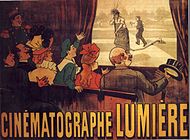George Melies and Early Special Effects
Georges Méliès was born 8 December 1861 and died 21 January 1938), his full name is Marie-Georges-Jean Méliès, was a French illusionist and filmmaker famous for leading many technical and narrative developments in the earliest days of cinema. Méliès, a prolific innovator in the use of special effects, accidentally discovered the substitution stop trick in 1896, and was one of the first filmmakers to usemultiple exposures, time-lapse photography, dissolves, and hand-painted color in his work. Because of his ability to seemingly manipulate and transform reality through cinematography, Méliès is sometimes referred to as the first "Cinemagician". Two of his best-known films are A Trip to the Moon (1902) and The Impossible Voyage (1904). Both stories involve strange, surreal voyages, somewhat in the style of Jules Verne, and are considered among the most important early science fiction films, though their approach is closer to fantasy. Méliès was also an early pioneer of horror cinema, which can be traced back to his Le Manoir du diable (1896).
In the Autumn of 1896, an event occurred which has since passed into film folklore and changed the way Méliès looked at filmmaking. Whilst filming a simple street scene, Méliès camera jammed and it took him a few seconds to rectify the problem. Thinking no more about the incident, Méliès processed the film and was struck by the effect such a incident had on the scene - objects suddenly appeared, disappeared or were transformed into other objects.
In 1900 Méliès had made 33 films, including the 13 minute Joan of Arc, starring Bleuette Bernon in the title role. He also made The One-Man Band, in which Méliès continued to fine tune his special effects by multiplying himself on camera to create a seven piece one man band.
Méliès discovered from this incident that cinema had the capacity for manipulating and distorting time and space. He expanded upon his initial ideas and devised some complex special effects.
He pioneered the first double exposure (La caverne Maudite, 1898), the first split screen with performers acting opposite themselves (Un Homme de tete, 1898), and the first dissolve (Cendrillon, 1899).
Méliès tackled a wide range of subjects as well as the fantasy films usually associated with him, including advertising films and serious dramas. He was also one of the first filmmakers to present nudity on screen with “Apres le Bal”.
Faced with a shrinking market once the novelty of his films began to wear off, Méliès abandoned film production in 1912. In 1915 he was forced to turn his innovative studio into a Variety Theatre and resumed his pre-film career as a Showman.
In 1923 he was declared bankrupt and his beloved Theatre Robert Houdin was demolished. Méliès almost disappeared into obscurity until the late 1920’s when his substantial contribution to cinema was recognised by the French and he was presented with the Legion of Honour and given a rent free apartment where he spent the remaining years of his life.
Georges Méliès died in 1938 after making over five hundred films in total - financing, directing, photographing and starring in nearly every one.
A Trip to the Moon is a 1902 French silent film directed by Georges Méliès. Inspired by a wide variety of sources, it follows a group of astronomers who travel to the Moon in a cannon-propelled spaceship, explore the Moon's surface, escape from an underground group of Selenites (lunar inhabitants), and return in a splashdown to Earth with a captive Selenite in tow.
 An internationally popular success at the time of its release, it is the best-known of the hundreds of films made by Méliès, and the moment in which the spaceship lands in the Moon's eye remains one of the most iconic images in the history of cinema. Each strip of film had been painted to give colour to such things as the dressed, the setting, the spaceship, etc. ( http://www.youtube.com/watch?v=7JDaOOw0MEE )
An internationally popular success at the time of its release, it is the best-known of the hundreds of films made by Méliès, and the moment in which the spaceship lands in the Moon's eye remains one of the most iconic images in the history of cinema. Each strip of film had been painted to give colour to such things as the dressed, the setting, the spaceship, etc. ( http://www.youtube.com/watch?v=7JDaOOw0MEE )List of films:
- Own Melies inspired video as created in class by yin similar techniques and ideas to create a short film. ( http://www.youtube.com/watch?v=0APOREMLt_A )
- "The Spider and the Butterfly" - http://www.youtube.com/watch?v=m89pDxu_pXc






